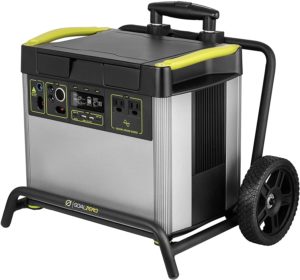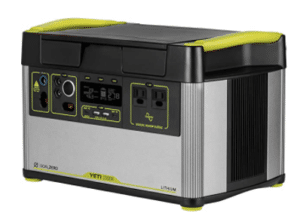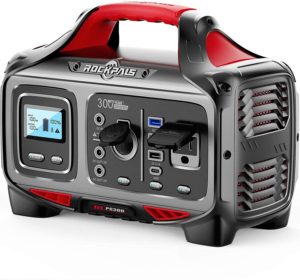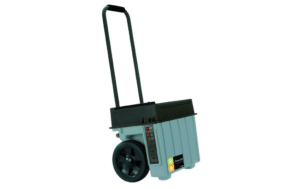If you’re looking for a truly eco-friendly backup generator to survive a blackout, consider getting a solar generator. These sun-powered generators are gas-free and silent, meaning they’re the perfect generator for a small apartment or home.
Table of Contents
Why doesn’t everyone just switch to solar generators, then? Well, for one thing, these generators aren’t as powerful as a gasoline, diesel, or propane generator. They’re also typically quite a bit more expensive than their gaseous counterparts, and they aren’t always charged and ready in case of an emergency.
Note: solar generators typically are not a viable solution for families looking to power an entire home in the event of an emergency. In an emergency, you will likely still need a gas generator. Make sure to check out our top picks for the best fuel-efficient portable generators, and if you’re not sure which size you need, we’ve written a guide for selecting the right-sized generator for your needs too.

The best large solar generator
What is a solar generator, anyway?
Solar generators are a backup energy source that runs on energy generated from solar panels.
Solar generators, while smaller than most gas generators, can also end up less compact overall when you factor in a solar panel or two, which you’ll need to keep the generator running. You can, and arguably should, pre-charge the battery in your solar generator in case of emergencies. You might also want to charge a spare battery at an outlet whenever you do have power from the grid.
See also: our guide to installing solar panels at home.
Solar generators typically can’t generate as much energy as you use, moment for moment. This means you’ll need to draw on stored energy to power higher demand equipment, such as a refrigerator or microwave, and keep charging the generator as it runs.
Amps and wattage for solar generators
Batteries in most portable solar generators store around 8,000mAh to around 50Ah or more. The smaller batteries offer enough juice to charge a smartphone two or three times. The larger can charge a phone 15 times or more. Bigger batteries are, well, bigger, which can cause storage problems in a small apartment. They’re also much more expensive. The price of lithium-ion batteries is coming down, however, especially with technological advances in this area.
In terms of wattage, most solar generators simply won’t have enough oomph to power a whole home A/C or other high-energy equipment. And some smaller solar models don’t have enough wattage to power a large TV or computer. As such, make sure you take the time to add up the wattage of everything you’ll absolutely need to power in case of a blackout.
It may make sense to get two solar generators that connect for higher wattage, or to save up for a more powerful model. Or, you might use a solar generator as your first backup generator, then supplement this with an old gas-powered generator if a blackout persists, while your solar panel recharges the battery.
Bear in mind that a light bulb may only take about 60 Watts to run, but a coffee maker or grill can draw 1,000-1,650 Watts. This may just mean that you have to unplug some items when you want to use others.
Our top picks for solar generators
If you’re set on a solar-powered generator, check out our top picks below!

Goal Zero Yeti 3000x Lithium Portable Power Station
Highlights: Our overall winner for the category, and the best large solar generator. Gasoline-free, silent power station that offers 3,500 Watts surge/start-up power.
| Power | 3,075 W |
| Inverter | Yes |
| Full load power time | 3,075 watt-hours (could run a fridge for 40 hours) |
| Full charge time from AC outlets | 25 hours / 14 hours |
| Weight | 78 lbs. (35.4 kg) |
The Goal Zero Yeti 3000x Lithium Portable Power Station is an upgrade of the discontinued 3000 model and now includes a 2000W AC inverter. This gasoline-free, silent power station offers 3,500 Watts start-up power and 1,500 W running wattage, is WiFi Mobile App Enabled, has seven versatile port options including fast-charging 60W USB-C Power Delivery, multiple USB-A ports, regulated 12V, and two 120V AC ports. This means you can run power tools, a refrigerator, an electric bike, laptop, phone, and more without worrying about surges ruining your sensitive equipment.
In short, the Yeti 3000x is as good as it gets when you’re looking for the most eco-friendly generator to survive a blackout. If you’re on the fence about a solar generator, the Yeti makes everything super easy. This is plug and play at its finest.
The Goal Zero Yeti 3000x Lithium Portable Power Station is an inverter generator, meaning your sensitive electronics are safe from surges in power. It stores 3,075 watt-hours in a replaceable lithium battery pack with a variety of high-power outputs capable of running 10 devices at once.
Your Yeti 3000x Lithium Portable Power Station could charge your smartphone more than 253 times, could recharge a laptop 61 times, could keep a full-size refrigerator running for about 55 hours and could power a 42-inch TV for 31 hours.
This generator could feasibly run most fridges, blenders, sump pumps, portable heaters, microwaves, swamp coolers, tools, and a TV, radio, laptop, and other devices, although not all at once or for weeks on end. The control panel (which has a handy backlit screen) lets you see easily how much power you’re using; how much power is being generated by solar panels or other inputs; and how much power you have left to draw on. There have been some gripes about the control panel not being entirely accurate, but the lovely thing about this type of generator is that the firmware can be easily updated when the company fixes bugs, which they seem to do pretty quickly.
The lithium ion battery pack has an in-built system to prevent overcharging, over-current, and short circuiting. It’s enclosed in a water-tight enclosure to seal it from the elements and this also allows you to replace the battery, adding durability and extra eco-friendliness to the generator. The Goal Zero Yeti Lithium 3000x also features an advanced cooling system to regulate temperatures of the whole system.
The Yeti 3000x comes fully recharges in 14 hours using the included 230W Power Supply AC Wall Charger. Or, charge it in 25 hours from regular AC outlets. If you’re fleeing a zombie apocalypse, you can also recharge on the go, thanks to the Yeti 3000’s built-in MPPT module that works with separate solar panels to recharge in as little as 6 hours of full sun. This seems extraordinarily fast to me, unless you’re running an 800 W solar array. With a 100 W solar panel, it will probably take around 48 hours to charge, which, bear in mind, is 48 hours of sun, not just two days (where many of those hours are dark, unless you live in the Yukon in summer). Realistically, then, you might need a whole week of sun to fully charge this beast.
Now, that said, once it’s charged, you’re only really going to need to keep topping up the battery. It’s extremely unlikely you’ll rip through all of the stored power, unless you’re hiding in a cave or there’s a cataclysmic event that blocks out the sun. (Actually, this fume-free generator would be ideal for a cave.)
The battery will hold a charge for 10-12 months, making this generator a great choice for emergencies. The manufacturers claim that a fully-charged Goal Zero Yeti 3000x Lithium can run a fridge for approximately 55 hours, whereas a 2000 W gasoline generator, offering around the same running wattage, would power the same fridge for just 6 hours on one tank of gas.
Because the Yeti 3000x allows for pass-through power, it can be charged while in use to extend runtimes. It weighs less than most equivalent gas generators when they’re full of gas and takes up around the same space (15.25 x 10.23 x 13.6 in or 38.74 x 25.98 x 34.54 cm). It also comes with a detachable roll cart, making it easy to move around, including to take it on a road trip for camping or tailgating.
One thing to note, however, is that solar generators require an operating temperature above freezing (32-104 F or 0-40 C). Otherwise, the batteries will rapidly lose power. Fortunately, because this generator doesn’t give off fumes and is silent, you can safely keep it indoors.
And, because there’s no engine in this thing, you don’t have to pay for fuel or worry about messy maintenance. These are the ideal generators for people who never thought they’d need or want to own a generator.
You can also connect to the generator with your smartphone and use the free Goal Zero Yeti App to check battery levels, turn ports on and off, and even update firmware. In fact, you might want to hack your power consumption even when there isn’t a blackout occurring! You could, for example, hook up your solar panels on your sunny balcony to charge your Yeti 3000 while you’re out at work all day and plug in your A/C but don’t turn on the port. Then, an hour or so before you’re due home, remotely activate the power station’s port for the A/C and draw back all that lovely free power you earned, thus lowering your energy bill.
Goal Zero like to make things really easy, which I appreciate. As such, you can quickly connect this generator with something like the Goal Zero Boulder 100 Briefcase (View on Amazon), a 100 Watt Monocrystalline Solar Panel, or save yourself $50 by ditching the handy briefcase feature and go for a more permanent panel (View on Amazon). Indeed, set up eight of these and you could fully charge your Yeti 3000 in about six hours of full sun.
And if you need even more power, Goal Zero just added a new model to their line-up: The Yeti 6000x (View on Amazon).

Goal Zero 1500x Yeti Portable Power Station
Highlights: Our favorite mid-sized solar generator. Has plenty of wattage to run a radio or TV, plus a refrigerator, microwave and a computer, while charging your phone and keeping the lights on. Now with more power as an upgrade to the 1250 model!
| Power | 1,516 W |
| Inverter | Yes |
| Full load power time | 1500 watt-hours (could run a full-size fridge for 28 hours) |
| Full charge time from AC outlets | 14 hours / 7 hours |
| Weight | 45.64 lbs (20.7 kg) |
The Goal Zero 1500x Yeti is pretty much a smaller version of my top pick in this category, providing 1,500 W of power rather than 3,000 W. This is an upgrade to the 1250 model that had a lead acid battery rather than a lithium ion battery – with the 1500x weighing less than half the 1250 (which was a whopping 100 lbs.-plus!).
With this extra power, you can run an emergency radio or TV to stay on top of the news, as well as a refrigerator, microwave, and a computer, while charging your phone and keeping the lights on. You can also very easily connect two or more of these portable power stations together to cover all your bases.
This generator offers running wattage of 1,500 W and 3,500 W surge from the 2000 W pure sine wave inverter. This generator features seven different port options including fast-charging 60W USB-C Power Delivery, multiple USB-A ports, regulated 12V, and two 120V AC ports.
Again, this solar generator can be charged using a separate solar panel and can be charged from an AC outlet. It produces no fumes, requires very little, if any, maintenance, and is basically noiseless. A US-based customer service center is on hand to answer any questions or concerns, should they arise.
In almost all other respects, this generator is the same as its larger version, with the same digital display, cooling technology, and so on. Pair this generator with something like the Goal Zero Boulder 100 Briefcase (View on Amazon), a 100 Watt Monocrystalline Solar Panel, or save yourself $50 by ditching the handy briefcase feature and go for a more permanent panel (View on Amazon). Indeed, set up four of these and you could fully charge your Yeti 1500 in about six hours of full sun. Or, recharge in about 14 hours from a 120 W AC outlet, or 7 hours from a 230 W outlet.
According to the manufacturer, the Yeti battery will function for 600-800 life cycles from full to empty. However, it’s vital that you charge the battery every 2-3 months even if it’s in long-term storage. That’s because a battery that is fully discharged for any length of time will more quickly lose its ability to hold a charge.

Rockpals 300W Portable Generator Lithium Portable Power Station
Highlights: Our favorite small generator of the bunch. At just 7.3 lbs, this generator is light enough to take on an overnight hike or camping and has enough juice to charge a smartphone 25 times, a laptop 4-5 times, and to power a mini car refrigerator for 3-5 hours.
| Power | 300 W |
| Inverter | Yes |
| Full load power time | 280 watt-hours (could run a fridge for 2-6 hours) |
| Full charge time from AC outlets | 6-7 hours |
| Weight | 7.3 lbs. (3.31 kg) |
The Rockpals 300 W Portable Generator has a 600 W surge max and 280 Wh CPAP Backup Battery Pack UPS Power Supply. This means it could just about power a refrigerator for 2-6 hours, although you’re more likely to rely on this generator for powering emergency equipment like a radio and lighting, smartphone, laptop, or even a CPAP machine, TV, or fan. In the Rockpals package, you get the generator, AC adaptor, car charger cable, MC4 adapter, user guide, and an 18-month warranty.
The Rockpals generator has four 12V and one 24V DC outlet, one pure sine wave 120 V AC outlet, two USB 2.1A outlets and two quick charge 3.0 USB outlets. The AC output port can charge devices less than 330W, the DC1 output can charge devices less than 96W, and the DC2 output can charge devices less than 48W. If you exceed 300 W, the generator will put itself into protection mode and you’ll need to charge it at a wall outlet to reset it.
At just 7.3 lbs, this generator is light enough to take on an overnight hike or camping and has enough juice to charge a smartphone 25 times, a laptop 4-5 times, and to power a mini car refrigerator for 3-5 hours. You can also hook it up to a solar panel or array for charging on the go as it supports pass-through charging.
Although mostly silent, this generator does make a slight noise when the cooling fan is activated. You may be able to get four nights’ worth of use out of this generator to power a CPAP while traveling; just be sure to read the advice to maximize efficiency and obtain the correct DC converter.

Bonus: Best Power Station – Xantrex 802-1500 XPower 1,500 Watt Portable Powerpack
Highlights: Our favorite portable power station. Clean, quiet, and relatively compact and lightweight, this portable power station has a 60 Amp/hour AGM battery with a 1500-watt inverter and produces a 3000-watt surge.
| Power | 1,500 W |
| Inverter | Yes |
| Full load power time | 1250 watt-hours (could run a fridge for 12-24 hours) |
| Full charge time from AC outlets | up to 15 hours |
| Weight | 60 lbs. (27.22 kg) |
The XPower Powerpack 1500 is a portable power system that can power appliances drawing 1500 Watts or less. Clean, quiet, and relatively compact and lightweight, this portable power station has a 60 Amp/hour AGM battery with a 1500-watt inverter and produces a 3000-watt surge. It can power your refrigerator, microwave, television, computer, and more, all thanks to stored electricity drawn from the grid, your vehicle, or from a solar panel.
The XPower Powerpack 1500 has a cart with a removable waist handle and two side carry handles that make it easy to move this power station from room to room or outdoors, including over rough terrain. The powerpack converts 12 V from the lead acid battery to household power, with both an AC and DC power panel.
The XPower Powerpack is an inverter generator, meaning it can be used for sensitive electronics. It has a built-in battery level indicator so you can easily check the charge, and it has a high surge protection, and automatic over-temperature and overload shutdown to prevent deep battery discharge.
The Powerpack takes up to 15 hours to fully charge from the electrical grid and can be charged in around 6-8 hours from a vehicle. It’s about half the price of the Goal Zero Yeti 1250 solar generator and has a lead-acid battery like the 1250 model. But it is a bit more rudimentary and requires a bit of technical savvy to hook it up to a solar array.
One thing to notice about this battery pack is that if you leave it sitting for too long (8 months or more), the batteries will likely have discharged to the point that they will no longer accept a charge. This can cause a dangerous situation where it looks like a battery is charging but it isn’t, because the lead acid has sulfated. In such a situation, the battery may overheat and start melting, leading to a potential fire hazard, the leaching of lead acid, and other hazards. If you have an old battery that has discharged, make sure to keep an eye on it if you do try to recharge. If it keeps ‘charging’ after it should be fully charged (around 15 hours for this battery pack), the battery may well be irretrievably damaged.
Should you consider a pedal power generator
If you’re inclined to weather a blackout by burning off energy through exercise, consider buying a pedal generator such as the K-Tor Power Box (View Price on Amazon). This pedal-powered emergency charger allows you to generate around 20 W without gasoline, propane, or sunlight, making it truly eco-friendly. It’s also arguably a great way to keep kids entertained and exercised. It’s also relatively inexpensive, at $189.50 or so, easily charges a number of types of batteries, has a universal outlet, can be operated using arms or legs, and is safe, compact, and sufficient to power an emergency radio, recharge a phone, or power other small devices.
The K-Tor Emergency Disaster Kit (View Price on Amazon) is another great option, featuring the 20 W Pedal Generator and a 10 W, 120 V Hand Crank Generator. With this, you can charge a dead cell phone in minutes. It’s a great gadget to have in the car, just in case, and costs just $234.95 or so. K-Tor products are also manufactured in the US.
Pedal power won’t be much help if you need to run a refrigerator, A/C, or other high-energy appliance.
The bottom line on solar generators
Solar generators can provide a valuable source of backup power, especially for van life, or for camping. However, consumers should know that, at present, solar generators are not an option for powering most homes in the event of an emergency.